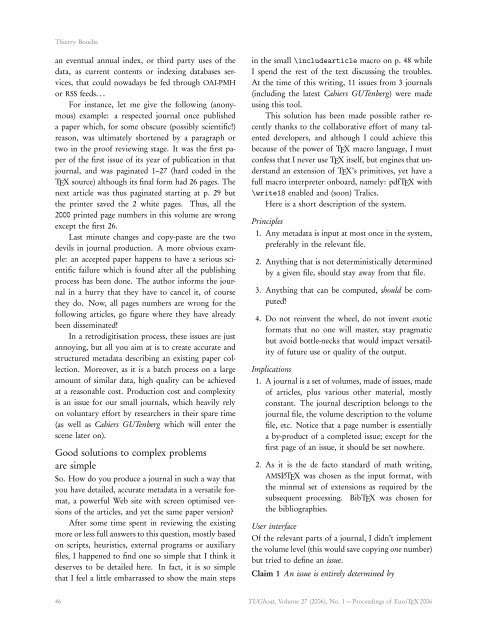The Communications of the TEX Users Group Volume 27 ... - TUG
The Communications of the TEX Users Group Volume 27 ... - TUG
The Communications of the TEX Users Group Volume 27 ... - TUG
Create successful ePaper yourself
Turn your PDF publications into a flip-book with our unique Google optimized e-Paper software.
Thierry Bouche<br />
an eventual annual index, or third party uses <strong>of</strong> <strong>the</strong><br />
data, as current contents or indexing databases services,<br />
that could nowadays be fed through OAI-PMH<br />
or RSS feeds. . .<br />
For instance, let me give <strong>the</strong> following (anonymous)<br />
example: a respected journal once published<br />
a paper which, for some obscure (possibly scientific!)<br />
reason, was ultimately shortened by a paragraph or<br />
two in <strong>the</strong> pro<strong>of</strong> reviewing stage. It was <strong>the</strong> first paper<br />
<strong>of</strong> <strong>the</strong> first issue <strong>of</strong> its year <strong>of</strong> publication in that<br />
journal, and was paginated 1–<strong>27</strong> (hard coded in <strong>the</strong><br />
<strong>TEX</strong> source) although its final form had 26 pages. <strong>The</strong><br />
next article was thus paginated starting at p. 29 but<br />
<strong>the</strong> printer saved <strong>the</strong> 2 white pages. Thus, all <strong>the</strong><br />
2000 printed page numbers in this volume are wrong<br />
except <strong>the</strong> first 26.<br />
Last minute changes and copy-paste are <strong>the</strong> two<br />
devils in journal production. A more obvious example:<br />
an accepted paper happens to have a serious scientific<br />
failure which is found after all <strong>the</strong> publishing<br />
process has been done. <strong>The</strong> author informs <strong>the</strong> journal<br />
in a hurry that <strong>the</strong>y have to cancel it, <strong>of</strong> course<br />
<strong>the</strong>y do. Now, all pages numbers are wrong for <strong>the</strong><br />
following articles, go figure where <strong>the</strong>y have already<br />
been disseminated!<br />
In a retrodigitisation process, <strong>the</strong>se issues are just<br />
annoying, but all you aim at is to create accurate and<br />
structured metadata describing an existing paper collection.<br />
Moreover, as it is a batch process on a large<br />
amount <strong>of</strong> similar data, high quality can be achieved<br />
at a reasonable cost. Production cost and complexity<br />
is an issue for our small journals, which heavily rely<br />
on voluntary effort by researchers in <strong>the</strong>ir spare time<br />
(as well as Cahiers GUTenberg which will enter <strong>the</strong><br />
scene later on).<br />
Good solutions to complex problems<br />
are simple<br />
So. How do you produce a journal in such a way that<br />
you have detailed, accurate metadata in a versatile format,<br />
a powerful Web site with screen optimised versions<br />
<strong>of</strong> <strong>the</strong> articles, and yet <strong>the</strong> same paper version?<br />
After some time spent in reviewing <strong>the</strong> existing<br />
more or less full answers to this question, mostly based<br />
on scripts, heuristics, external programs or auxiliary<br />
files, I happened to find one so simple that I think it<br />
deserves to be detailed here. In fact, it is so simple<br />
that I feel a little embarrassed to show <strong>the</strong> main steps<br />
in <strong>the</strong> small \includearticle macro on p. 48 while<br />
I spend <strong>the</strong> rest <strong>of</strong> <strong>the</strong> text discussing <strong>the</strong> troubles.<br />
At <strong>the</strong> time <strong>of</strong> this writing, 11 issues from 3 journals<br />
(including <strong>the</strong> latest Cahiers GUTenberg) were made<br />
using this tool.<br />
This solution has been made possible ra<strong>the</strong>r recently<br />
thanks to <strong>the</strong> collaborative effort <strong>of</strong> many talented<br />
developers, and although I could achieve this<br />
because <strong>of</strong> <strong>the</strong> power <strong>of</strong> <strong>TEX</strong> macro language, I must<br />
confess that I never use <strong>TEX</strong> itself, but engines that understand<br />
an extension <strong>of</strong> <strong>TEX</strong>’s primitives, yet have a<br />
full macro interpreter onboard, namely: pdf<strong>TEX</strong> with<br />
\write18 enabled and (soon) Tralics.<br />
Here is a short description <strong>of</strong> <strong>the</strong> system.<br />
Principles<br />
1. Any metadata is input at most once in <strong>the</strong> system,<br />
preferably in <strong>the</strong> relevant file.<br />
2. Anything that is not deterministically determined<br />
by a given file, should stay away from that file.<br />
3. Anything that can be computed, should be computed!<br />
4. Do not reinvent <strong>the</strong> wheel, do not invent exotic<br />
formats that no one will master, stay pragmatic<br />
but avoid bottle-necks that would impact versatility<br />
<strong>of</strong> future use or quality <strong>of</strong> <strong>the</strong> output.<br />
Implications<br />
1. A journal is a set <strong>of</strong> volumes, made <strong>of</strong> issues, made<br />
<strong>of</strong> articles, plus various o<strong>the</strong>r material, mostly<br />
constant. <strong>The</strong> journal description belongs to <strong>the</strong><br />
journal file, <strong>the</strong> volume description to <strong>the</strong> volume<br />
file, etc. Notice that a page number is essentially<br />
a by-product <strong>of</strong> a completed issue; except for <strong>the</strong><br />
first page <strong>of</strong> an issue, it should be set nowhere.<br />
2. As it is <strong>the</strong> de facto standard <strong>of</strong> math writing,<br />
AMSL A<strong>TEX</strong> was chosen as <strong>the</strong> input format, with<br />
<strong>the</strong> minmal set <strong>of</strong> extensions as required by <strong>the</strong><br />
subsequent processing. Bib<strong>TEX</strong> was chosen for<br />
<strong>the</strong> bibliographies.<br />
User interface<br />
Of <strong>the</strong> relevant parts <strong>of</strong> a journal, I didn’t implement<br />
<strong>the</strong> volume level (this would save copying one number)<br />
but tried to define an issue.<br />
Claim 1 An issue is entirely determined by<br />
46 <strong>TUG</strong>boat, <strong>Volume</strong> <strong>27</strong> (2006), No. 1 — Proceedings <strong>of</strong> Euro<strong>TEX</strong> 2006

















